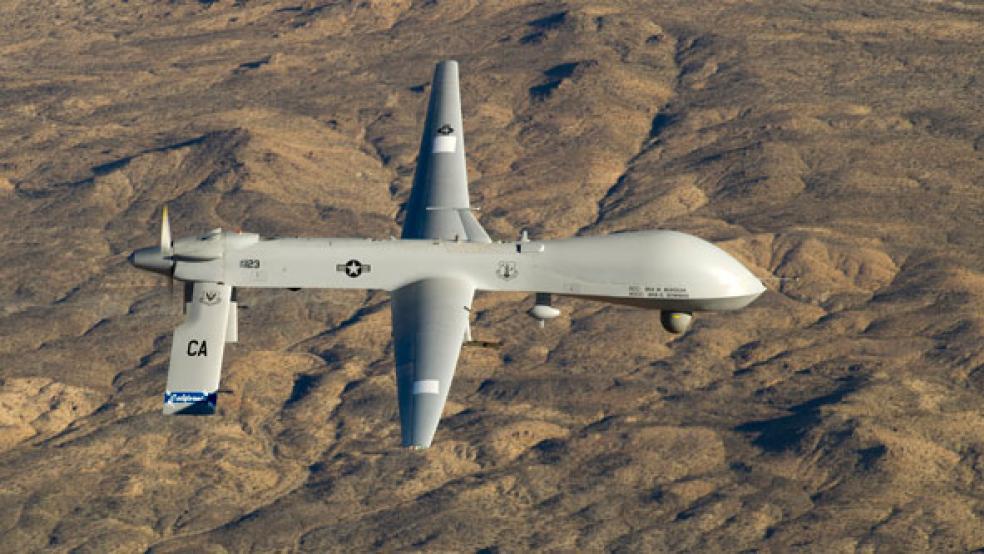As Defense Secretary Ashton Carter settles into office, a formidable challenge awaits him: eradicating the menace of the Islamic State, or ISIS, in Syria and Iraq. In his Senate confirmation hearing, Carter reiterated that he and the Obama administration hope “with our air power and other kinds of assistance, [to] inflict defeat on ISIS, and then make it a lasting defeat.”
Critics inside and outside the Pentagon have repeatedly warned that our current limited use of air power makes that goal virtually impossible to achieve. But too little credit has been given to the success of America’s drone fleet against ISIS so far, and too little has been said about the kind of sustained drone mission that is needed going forward to secure U.S. gains against ISIS.
Related: This Lethal Laser Could Cripple ISIS and Other Enemies
Indeed, in five months of bombing byU.S. and allied air forces have run on average five to 10 sorties a day againstISIS targets. That’s barely a pinprick compared to the more than 1,100 sorties per day conducted during Desert Storm, or even the 87 per day U.S. Central Command ran during Operation Enduring Freedom in Afghanistan.
Yet here Carter will face a painful dilemma. On one hand, increasing the number of air strikes by F-16s and F-18s also increases the chances of a plane being shot down or experiencing mechanical failure. It also risks an American being captured and facing the same horrific fate as Jordanian pilot Maaz al-Kasasbeh. The other alternative—sending large numbers of American ground troops into a country where the United States already sacrificed more than 4,400 lives—is even more unpalatable.
Fortunately, Carter will have at hand the perfect tool for delivering a series of mortal blows against ISIS without putting a single American soldier on the ground: America’s fleet of unmanned aerial vehicles, or UAV’s.
Of course, UAV’s now fly routinely over the ISIS battlefield conducting reconnaissance and combat.
Related: Why We Have to Worry About ISIS South of the Border
However, instead of launching occasional missile strikes as they do now, the key to defeating ISIS must be a systematic and sustained drone air campaign in support of Kurdish and Iraqi forces—in effect a high-tech upgrading of a proven battlefield strategy first employed by George Patton’s Third Army during World War IIand by U.S. Marines in Korea.
This unmanned air campaign—the first in history—would use the deadly and precise firepower of our UAV fleet to find, fix and devastate ISIS troops, vehicles and buildings on a 24/7 basis, so that Kurdish Peshmerga and other troops can advance and retake cleared territory.
Something similar happened more recently, almost by accident, in Kosovo in 1999, when persistent NATO air strikes so cleared away Serbian resistance that Kosovar militias were able to come down from surrounding hills and retake lost ground. In Iraq and Syria, the first step would be to increase to at least 10 the number of GPS-guided round-the-clock orbits used byUAV’s covering ISIS strongholds. This would enable UAVreconnaissance craft like the Global Hawk and Sentinel, and armed drones like the Predator and Reaper, to enter the battle space in numbers large enough (for example, 30 to 40 at a time) for systematic and unrelenting air strikes.
Second, U.S. special operations teams with Global Hawks and Sentinels would then search out and identify suitable targets in those ISIS concentrated areas.
Related: Drone War in Ukraine Forces Big Tech Changes
Third, since ISIS lacks any sophisticated air defense system or any other way to challenge unmanned air supremacy, dozens of armed drones could enter the air space at 15-20,000 feet—above ground fire weaponry but low enough for precision target identification and strike— and in coordination with Kurdish and Iraqi security forces strike at those targets at will, without letting up, day and night.
Finally, as ISIS is steadily degraded by the unrelenting unmanned air strikes, Iraqi security forces with American advisors will be able to move up and regain cleared ground. Then special operations forces would help the next echelon of reconnaissance UAV’s to identify brand-new enemy concentrations, even as the UAV strike fleet rearms for battle—and the cycle begins again.
The UAV air campaign option is particularly attractive because it uses these aircraft’s most important virtues: their round-the-clock situational awareness, their persistent flight time (an armed Reaper can stay aloft 27 hours without refueling compared to a couple of hours for a typical F-16 sortie), their capacity for sudden precise strike and maneuver with 16 Hellfire missiles or four 500-lb. bombs for every Reaper.
Related: 12 Weird Uses for Drones
Perhaps just as importantly, they are entirely expendable if they crash or are shot down—while their operators are safe far from the battlefield.
A systematic air campaign also can quickly clear the way for relief workers to move freely into liberated areas and offer help to refugees like the Izidis. Indeed, in a matter of weeks most would be able to return home as the dangers of an Islamist victory fade—and the destruction of ISIS forces becomes a reality.
Far from being a Jules Verne fantasy, the technology for such a campaign is all but ready to deploy. By using it, Carter could guarantee the defeat of ISIS and save thousands of lives. By giving UAV’s the mission of defeating a conventional armed enemy on the battlefield for the first time in history, he will also change the face of modern war.
Arthur Herman is senior fellow at Hudson Institute and author of Freedom’s Forge: How American Business Produced Victory in World War II. He has previously consulted for drone manufacturer General Atomics. William Luti is vice president at Hudson Institute, a retired naval officer and former special assistant to President George W. Bush for defense policy and strategy.
This article originally appeared in Defense One.
Read more at Defense One:
Pentagon Intel Analysts May Soon Use a Trick from Amazon's Book
Navy to Increase the Number of Deployed Ships to the Middle East, Asia
Obama's ISIS War Powers Request Is Going Nowhere





